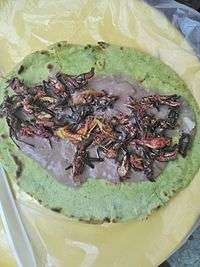Chapulines
Chapulines, plural for chapulín (Spanish: [tʃapuˈlin] (![]()

They are collected only at certain times of year (from their hatching in early May through the late summer/early autumn). They are toasted on a comal. Often they are seasoned with garlic, lime juice and salt, sometimes with an extract of Maguey worms, lending a sour-spicy-salty taste to the finished product.
One of the regions of Mexico where chapulines are most widely consumed is Oaxaca, where they are sold as snacks at local sports events and are becoming revived among foodies.[1] There is one reference to grasshoppers that are eaten in early records of the Spanish conquest, in early to mid 16th century.[2]
Besides Oaxaca, chapulines are popular in areas surrounding Mexico City, such as Tepoztlán, Cuernavaca and Puebla. They may be eaten individually as a botana (snack) or as a filling, e.g. tlayuda filled with chapulines. The Seattle Mariners successfully introduced chapulines as a novelty snack in their 2017 home games.[3]
Health risks

In 2007, several American media reported concerns over lead contamination in products imported from Zimatlán, a municipality in Oaxaca, including chapulines.[4] In California, an investigation among community residents in Monterey County showed a larger risk for lead poisoning on people who either were from or reported eating food imported from Zimatlán.

Contaminated chapulines which were found for sale in California were also identified in samples from Zimatlán.[5] Lead levels found in the chapulines were as high as 300 times the maximum recommended lead dose for children under the age of 6 and pregnant women. It was discovered the lead was from bowls used in the seasoning process. The lead problem was widely known and is no longer an issue.
See also
- Entomophagy – The practice of eating insects
- List of Mexican dishes – Wikipedia list article
- List of Spanish words of Nahuatl origin – Wikipedia list article
- Chapulín de la milpa (Sphenarium purpurascens), a grasshopper species found in Mexico and Guatemala

References
- "Chapulines and Food Choices in Rural Oaxaca". Jeffrey H. Cohen, Nydia Delhi Mata Sanchez, and Francisco Montiel-Ishino. Gastronomica. Vol (90)1: 61-65, 2009.
- Fray Bernardino de Sahagún, General History of the Things of New Spain: Florentine Codex, Book 11 Earthly Things
- Vinh, Tan (17 April 2017). "Get your fried grasshoppers here: the big hit at Mariners home games". The Seattle Times. Retrieved 2 November 2017.
- American Journal of Public Health, May, 2007
- International Journal of Epidemiology, December, 2007
External links
| Wikimedia Commons has media related to Chapulines. |


.jpg)
